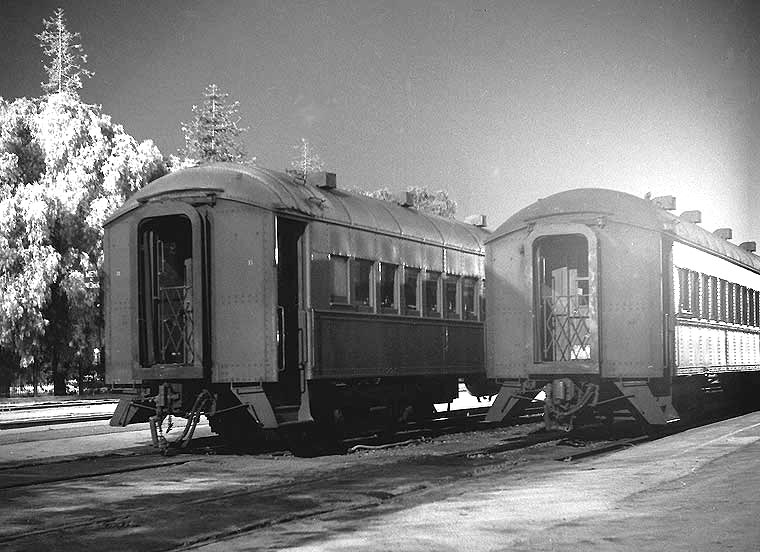
San Jose, Jan.1969.
Commute Cars Introduction Southern Pacific's basic steel commute fleet roster was pretty uncomplicated. The 72 foot "Suburbans", more commonly called "Subs" arrived in three groups in 1923-27. During the 1930's 60 foot Harrimans (SP's first steel mainline passenger cars) were gradually phased-in to replace the the remaining wooden commute cars.
World War II was an 'anything-goes' propostion on the Peninsula. SP regularly robbed the commute fleet of cars for troop trains, and replaced them with lounge, observation and dining cars, or whatever else was available. Possibly, some wooden cars returned to the Peninsula after transporting Japanese-ancestry U. S citizens to internment camps. In addition, SP leased 19 Central Railroad of New Jersey cars.
The first ten "Gallery" cars arrived in 1955, with 21 more showing-up just after steam was eliminated in early 1957. At this point, at about the historic ridership peak, the fleet stood at 31 Gallery cars, 75 Subs, and 90 Harrimans.
By the middle Sixties, ridership had declined so much that all of the Harrimans were gone. At the same time, SP was trying despirately to rid itself of the commute trains, at one point suggesting that it would purchase sufficient vans to replace the trains! The California PUC took a dim view of SP's pleas and ordered the company to begin replacing the subs with newer equipment.
SP would have preferred the replacements to be surplus streamlined coaches, and placed one car, # 2202 into the Commute Pool for the passengers to try out. A poll of passengers indicated that they preferred more Gallery cars, so SP ordered 15 more, which were delivered in early 1968 and allowed the retirement of more subs.
The Galleries and remaining Subs handled things until the arrival of push-pull equipment in 1985.
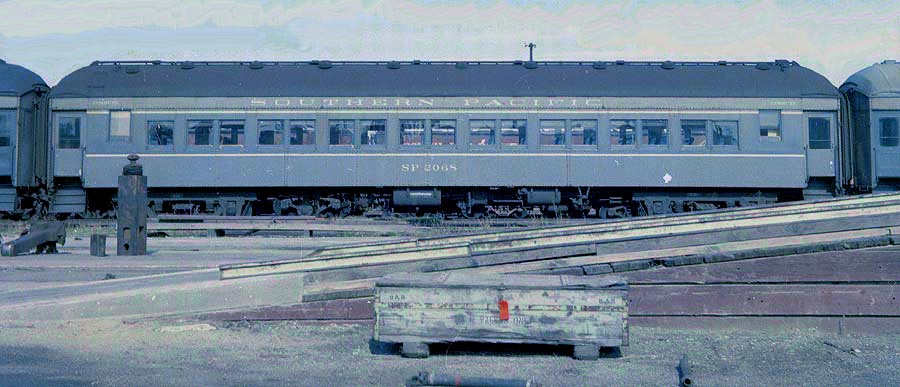
Harriam 60 foot coach # 2068 is one of several languishing in the weeds at the College Park rip track, in August of 1965. This was the last time I saw Harrimans on the Peninsula, although an early 1966 count published in the Westren Railroader (Issue 314) showed the 2068 and twelve sisters still on the Commute roster, with two others on loan to the McCloud River Railroad.
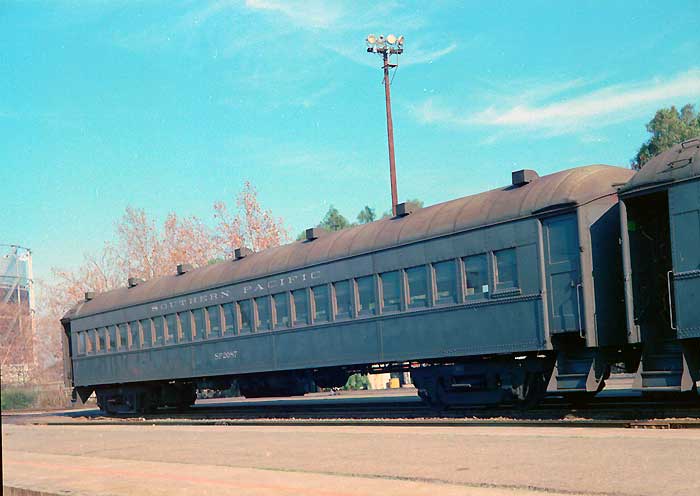
Sub # 2087 in the latter all-grey scheme sits on Depot 1 in January, 1966. Despite that the SP wanted to rid itself of the Peninsula Commutes in the worst way, Number One Market still insisted that the equipment be clean, well-painted and in good repair. In those days, the trains primarily hauled people to / from San Francisco's Market Street Financial District, the SP wanted no public relations disasters based upon poor service.
SP still insisted upon economies, though. While the sides and truck sideframes of the above car were well=painted, the remaining exterior was not. In fact, the side paint was so liberally applied that it actually was the car side after the underlying sheet metal had rotted away. This was particularly true on the outside of the toilet compartments (almost all of which were permanently closed-off in latter years). One day in 1979, Brakeman Me stood next to a Sub's toilet location awaiting departure time, when I perchanced to lean up against the car. Yup, my hand went right through innumerable layers of paint, and one layer of rust.
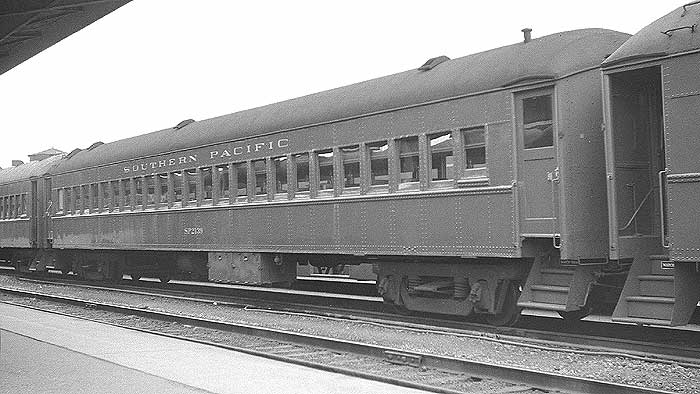
Sub # 2139 possessed oddball roof vents. I believe that a couple of others also shared this feature. I have no idea what the deal was. Late 1968.
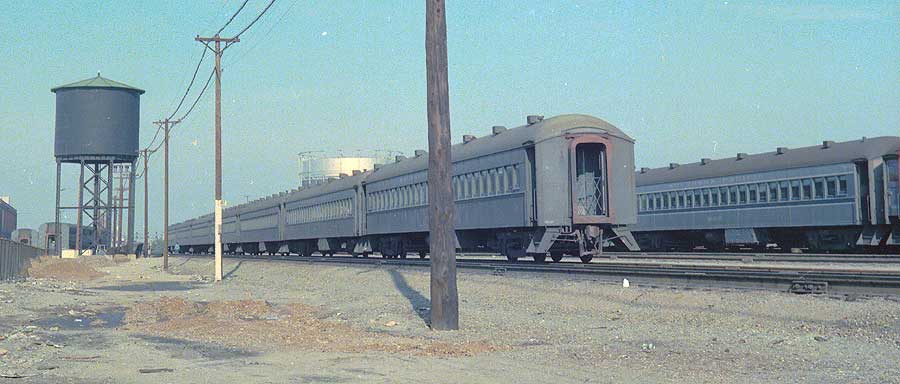
Unlike working more modern vestibule trap doors, where the footplate folds up against the door similtaneously as the door is opened, with Subs it was a two-step process. First, you opened the rather flimsy wooden vestibule door (the windows were plastic for good reason). Then you stomped on the footplate latch, hopefully causing the spring-loaded footplate to pop-up enough to catch the underside with the toe of your shoe and lift it high enough to grab it with your hand. I still own a pair of black oxfords with worn-out toes.
Each brakeman (or "doorslammer" as switchmen called him, for obvious reasons) was responsible for three cars. Excepting express runs, where all of the doors usually were kept closed until the first stop, trains ran with the traps open. By rule, the traps were to be open on one side only, lest the passengers exit the train on the wrong side, which was often quite a drop.
Now, if you were working a westbound train, opening and closing traps could be quite a workout. For instance, California Avenue's station was on the left side; Palo Alto's on the right; Menlo Park's on the left, again. Only two to two-and-one-half minutes running time separated the stations, so if the aisles were crowded and you also had a reluctant trap, or two, it was pretty much impossible to open all of the doors all of the time.
Sometimes a friendly helper conductor would lend a hand, but rarely the head conductor. Passengers, who tended to ride the same trains each day knew the routine, and would usually open traps themselves, a big no-no (they weren't even supposed to be in the vestibule until the train stopped - HA!), but we brakemen turned a blind eye to this at busy times.
Another big no-no (but some of the senior brakemen did it anyway) was to "stagger the traps", whereby at ajoining ends you opened the trap on the left side of one car and the right side of another. But even the laziest brakeman considered it dangerous to open the traps on both sides of a vestibule - this formed a pretty narrow peninsula between cars for passengersto negotiate as the train rocked along at 70 mph.
At either end of the line, brakeman had to know which side of the cars that the passengers would detrain, so my timetable was full of little "L's" and "R's". There was this darn operator at Fourth Street Tower that was forever putting my train down the wrong track...
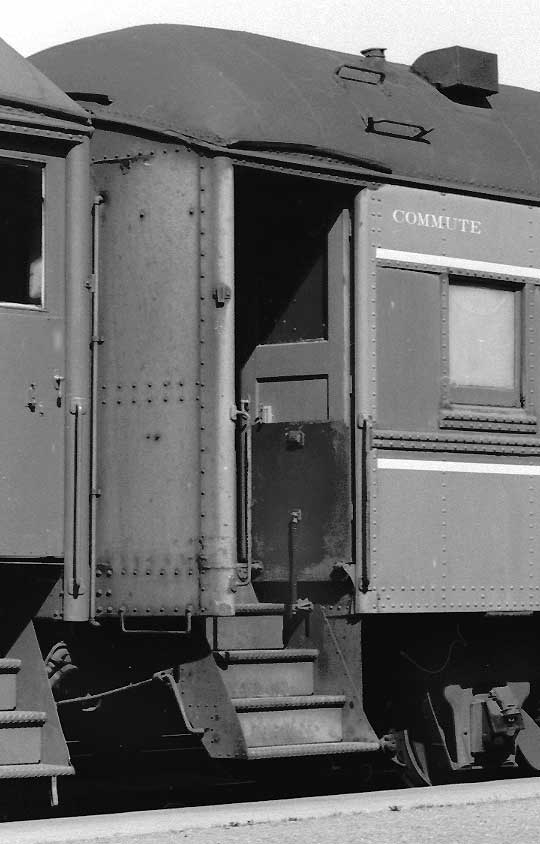
Also in the vestibule was a pull-handle to dump the steam (visible in the vestibule of car next to # 2139 in page middle, above). For example, going westbound, you signalled the engineer to shut off the steam (to his look of "Don't you think that I know that?") at San Bruno, then you dumped the steam west of Butler Road someplace. If you didn't, the poor carman in the City could be scalded by steam and hot water, if he made a cut in an undrained steam line,
One vestibule also contained a retainer valve, which you would crack open to eight o'clock to hear the "putt" of the brakes setting-up and the "sigh" of them releasing during a running air test. To give the engineer a "highball the running air", you'd reach inside the car's end door and give a good yank on the pneumatic signal line. Actually, despite the signals proscribed in the rule book, all signal line communications on the Commutes were generally one yank, because the whistle in the cab would continue sounding for a considerable time after the signal cord was released. How the engineer would react was situational: start, stop, stop at the next station (for flag stops), or running air.
The vestibule's most confounding device was the old-fashioned verticle staff hand brake. No gear-reduction power brakes, these - the brake chain merely wrapped around the bottom of the staff. Rather than a wheel, these brakes were applied by pulling with all of your might upon a cantankerous arm, which theoretically worked like a ratchet wrench and folded down when not in use. The ratchets were often in ill repair, and/or the arms were loose and wobbily. Compounding things was that you had to hold the side of your foot up against another ratchet's "dog" at floor level to keep the brake staff from unwinding, not always a successful proposition, and certainly awkward at the least. No wonder so many brakemen fell off of boxcar roofs trying to tie these things.
One more thing: the Subs had excellent cast iron brakes. When throwing a train into emergency from the rear end using the conductor's valve, the correct method was to first pull it out enough to set-up the brakes, then yank on it the rest of the way to big hole the train. If you did it all at once,there was a good chance that you'd break the train in two, even if the slack was stretched.
